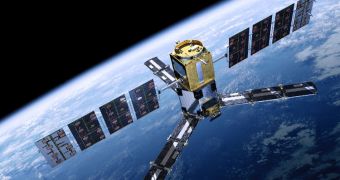European Space Agency (ESA) experts managing the Soil Moisture and Ocean Salinity (SMOS) satellite were just awarded the prestigious Certificate of Recognition by the IEEE Geoscience and Remote Sensing Society. The prize comes just two years after the spacecraft was launched.
Back in November 2009, SMOS became the first satellite ever to carry a synthetic aperture microwave radiometer to space for Earth observations. The main goal this mission has is to provide a more accurate understanding of the planet's water cycle.
At the same time, it also investigates issues related to climate change, all while providing scientists with more data to help with creating more accurate weather predictions. Monitoring snow and ice accumulations around the world are also important objective for the satellite.
SMOS is scheduled to conduct a 3-year mission, of which nearly 24 months have already passed. In recognition of its success, the mission was recently recognized by the Institute of Electrical and Electronics Engineers (IEEE), which features 400,000 members in 160+ countries.
The Geoscience and Remote Sensing Society (GRSS) is an organization within the IEEE that only awards prizes once every two to three years, and only when an achievement calls for such recognition.
All these traits make the award very prestigious in the scientific community, and ESA reports that the SMOS science and managing team was extremely proud for having their contributions to advancing science recognized in this manner.
The prize was received jointly by ESA official Manuel Martin-Neira, French Center for the Study of the Biosphere representative Yann Kerr and Spanish Institute of Marine Sciences expert Jordi Font.
SMOS is “using novel techniques to provide global maps of the moisture held in the top layers of soil and salt in the surface waters of the oceans,” a press release from the space agency reads.
“This information is leading to a better understanding of the water cycle and, in particular, the exchange processes between Earth's surface and the atmosphere,” the statement goes on to say.
“On behalf of my colleagues Yann and Jordi, and all the people who have been involved in the instrument development and in the SMOS project, I would like to express my deepest gratitude to the Administrative Committee of the IEEE Geoscience and Remote Sensing Society for the honour of this award,” Dr. Martin-Neira adds.
The 658-kilogram spacecraft was launched on November 2, 2009, from the Plesetsk Cosmodrome in northern Russia. It was delivered to orbit by a SS-19 Rokot rocket, which is a derivative of the Russian SS-18 Stiletto intercontinental ballistic missile.

 14 DAY TRIAL //
14 DAY TRIAL //